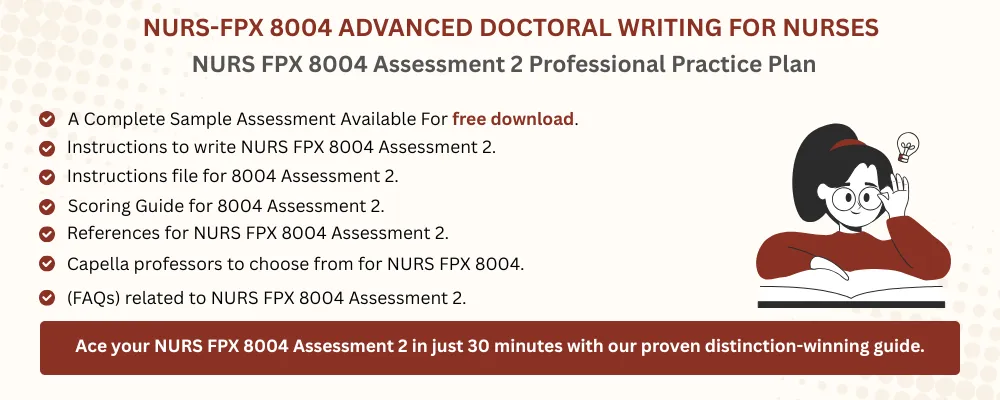NURS FPX 8004 Assessment 2 Sample FREE DOWNLOAD
NURS-FPX 8004 Assessment 2 Professional Practice Plan
Student name
Capella University
NURS-FPX8004
Professor Name
Submission Date
Introduction
The practice site has a critical issue of delayed diagnosis in the early detection and identification of pulmonary hypertension (PH) in the pediatric population, which has led to poor outcomes and quality of life. In pediatric patients referred to pulmonary evaluation, more than 40 percent of the patients had moderate to severe PH when they were diagnosed on site (Executive Nurse, personal communication, May 20, 2025). At the national level, delays that exceed one year in the diagnosis are found to be consistent (DuBrock et al., 2023). The slowness is only explained by general initial symptoms and how providers keep varying their diagnostic methods. The absence of quality PH screening protocols on the site results in delayed diagnosis, which causes not only the progression of the disease but also the rise of healthcare expenses.
Sealing the described gap is necessary to enhance clinical efficiencies, quality, and long-term patient outcomes. The practice gap concerning the ineffective PH screening practices on the pediatric patients shows that a quality improvement initiative is necessary with the goal of achieving better diagnosis by 25 percent or more in six months. The goal of the quality improvement project is to improve the rate of diagnosis of pediatric PH at the practice site, which will be measurable using standardized screening procedures as outlined in the project question.
Population
The practice site includes pediatric patients of 0-10 years referred to a pulmonary specialty clinic to determine the etiology of unexplained respiratory symptoms. Patients are usually subjected to diagnostic tests, which will include chest radiography and pulmonary function tests. The pediatric patients are first suspected to have asthma, viral illness, or congenital heart disease, and this may contribute to the delay in proper referral to get PH assessment (Wacker & Beghetti, 2025).
The population impact of the practice problem, e.g., slow diagnosis and identification of PH, is that it enables the disease to reach moderate or severe stages before diagnosis, reduces the efficiency of treatment, and deteriorates long-term outcomes (Executive Nurse, personal communication, May 20, 2025). The inclusion criteria are all pediatric patients referred to PH evaluation who are not known to have PH established. The exclusion criteria are patients who are diagnosed with PH or patients referred due to an unrelated condition (neurological or dermatologic). Therefore, the requirements reveal that the project includes only the main population.
Stakeholder
The stakeholders of the practice site are the pediatric pulmonologists, nurse practitioners, the referring primary care providers, care coordinators, and executive leadership of the clinic. Pediatric pulmonologists and cardiologists are those who diagnose and treat PH in children and are essential in the interpretation of diagnostic data and formulation of effective treatment strategies (Varghese et al., 2024). Nurse practitioners are the first point of contact in assessments and follow-ups, and clinical judgment determines how the referral and investigation proceed. Care coordinators help with patient navigation and liaise with providers to ensure the best, timely access to diagnostic tests. Another stakeholder involved in the implementation of quality improvement initiatives is the executive leadership, including the clinical director.
By helping to engage the stakeholders and enhancing the likelihood of the project’s success, the message about the improvement practices will be positioned in each stakeholder group based on the specific set of roles, responsibilities, and priorities. Clinical providers will be informed about the most crucial information about how the project enhances the accuracy of the diagnosis and helps patients. The meetings of teams will be organized to address the necessity of change in the practices of early PH recognition and the advantages of uniform screening procedures (Gillmeyer et al., 2022). Communications among nurse providers aim at promoting patient compliance with the follow-up appointment to facilitate timely referral. The physical team meetings with the nurses help convey the importance of the patient attending the follow-up session. The care coordinators will participate in discussions aimed at streamlining patient diagnostic processes (Giri et al., 2021). The use of two-way communication will illustrate how the processes will be simplified and enhance the early diagnosis by increasing patient adherence to the tests.
The messages to the executive leadership are aimed at discussing the organizational-level performance indicators and ways to enhance the quality standards of care. The messages will be communicated to the executives using the presentations to facilitate the implementation of the plan (Brewer et al., 2021). To achieve cooperation and collaboration in the proposed site, the approach will be to engage the stakeholders early by holding organized meetings, clearly explaining the purpose and the benefits of the project, and integrating the feedback to build shared ownership (Varghese et al., 2024). Consequently, the team meetings, presentations, two-way communication, and the Q&A session will help prioritize the interests and views of every stakeholder group to enhance the diagnosis of the PH in the pediatric patients at the project site.
Project Question
The project clinical problem can be constructed in the population, intervention, comparison, outcome, and time (PICOT) format that can inform the formulation of a quality improvement initiative. The labels and the PICOT question are as follows; In pediatric patients aged 0 to 10 years at risk of PH (P), how does the introduction of a standardized screening protocol of PH (I) compared to the existing practices of non-use of the standardized tool (C) improve the diagnosis of PH by 25 percent (O) within a six-month (T)? The question addressed the necessity to apply the evidence-based screening method to enhance the early diagnosis of the PH in children. In this way, the results would be evaluated by a quantifiable enhancement in the PH diagnostic rate among pediatric patients. Thus, the PICOT question is devoted to improving clinical outcomes and compliance with best practices.
Conclusion
In the professional practice plan, the information on the practice site, practice problem, population, stakeholder, and PICOT question is presented. The plan aims to bridge the practice gap in delayed pediatric PH diagnosis by introducing a quality improvement initiative. The main population includes pediatric patients, aged 0-10 years. In addition, the details of the communication strategy to reach the stakeholders to implement the plan are given. It also emphasizes the importance of interdisciplinary collaboration to ensure effective implementation and sustainability of the initiative. The plan also highlights the role of evidence-based strategies in guiding decision-making and ensuring improved patient outcomes. Moreover, the project question contains the information on the proposed intervention that results in measurable outcomes.
Related Free Assessments for NURS-FPX8004
Instructions To Write NURS FPX 8004 Assessment 2
If you need guidance to write your NURS FPX 8004 Assessment 2 Professional Practice Plan, contact Tutors Academy. Our expert tutors are ready to help you succeed!
Instruction file for 8004 Assessment 2
Contact us to get the instruction file for this assessment.
Scoring Guide for 8004 Assessment 2
Contact us to get the Scoring file for this assessment.
References For NURS FPX 8004 Assessment 2
Brewer, J., Bartlett, M., Harris, D., & Hui, C. (2021). Improving communication between healthcare providers and pulmonary arterial hypertension patients: A survey of patient preferences. Pulmonary Circulation, 11(2), 1-8. https://doi.org/10.1177/20458940211015813
DuBrock, H. M., Germack, H. D., Loiselle, M. G., Linder, J., Satija, A., Manceur, A. M., Cloutier, M., Lefebvre, P., Panjabi, S., & Frantz, R. P. (2023). Economic burden of delayed diagnosis in patients with pulmonary arterial hypertension (PAH). PharmacoEconomics – Open, 8(3), 133–146. https://doi.org/10.1007/s41669-023-00453-8
Gillmeyer, K. R., Johnson, S. W., Bolton, R. E., McCullough, M. B., & Wiener. R. S. (2022). Organization of pulmonary hypertension care in non‐expert care settings: Lessons learned from a multi‐site study. Health Services Research, 58(3), 663–673. https://doi.org/10.1111/1475-6773.14114
Giri, P. C., Stevens, G. J., Merrill‐Henry, J., Oyoyo, U., & Balasubramanian, V. P. (2021). Participation in pulmonary hypertension support group improves patient‐reported health quality outcomes: A patient and caregiver survey. Pulmonary Circulation, 11(2), 1–11. https://doi.org/10.1177/20458940211013258
Varghese, N. P., Austin, E. D., Galambos, C., Mullen, M. P., Yung, D., R. Guillerman, P., Vargas, S. O., Avitabile, C. M., Chartan, C. A., Santiago, N. C., Ibach, M., Jackson, E. O., Jarrell, J. A., Keller, R. L., Krishnan, U. S., Patel, K. R., Pogoriler, J., Whalen, E. C., Brokamp, K., & Villafranco, N. M. (2024). An interdisciplinary consensus approach to pulmonary hypertension in developmental lung disorders. European Respiratory Journal, 64(3), e2400639. https://doi.org/10.1183/13993003.00639-2024
Wacker, J., & Beghetti, M. (2025). Pulmonary hypertension in pediatrics: From clinical suspicion to management. European Journal of Pediatrics, 184(5), 288. https://doi.org/10.1007/s00431-025-06099-4
Best Professors To Choose From For 8004 Class
- Lisa Kreeger, PhD, RN
- Linda Matheson, PhD
- Donna Hill, DNP, MSN
- Audra Somes
- Helena M. H. Nadder, PhD
(FAQs) related to NURS-FPX 8004 Assessment 2
Question 1: From where can I download a free sample for NURS FPX 8004 Assessment 2?
Answer 1: You can download a free sample for NURS FPX 8004 Assessment 2 from the Tutors Academy website.
Do you need a tutor to help with this paper for you with in 24 hours.
- 0% Plagiarised
- 0% AI
- Distinguish grades guarantee
- 24 hour delivery

